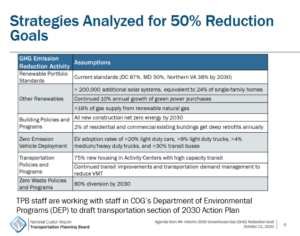
The above slide, from a presentation to the National Capital Region Transportation Planning Board (TPB) set for October 21, 2020, lists potential strategies to half the D.C. Region’s greenhouse gas (GHG) emissions from 2005 levels over the next ten years. The next step will be to draft and adopt a 2030 GHG Emissions Action Plan.
***
On October 16, 2020, Active Prince William Chair, Rick Holt, sent the following statement to Prince William County’s representatives on the National Capital Region Transportation Planning Board (TPB)–Prince William Board of County Supervisors Chairman Ann Wheeler and Neabsco District Supervisor Victor Angry. The TPB is scheduled to adopt an ambitious interim 10-year goal to address climate change, by reducing the D.C. region’s emissions of greenhouse gases 50% from their baseline, 2005 level by the year 2030.
***
On October 14, the Metropolitan Washington Council of Governments (COG) Board of Directors pledged to lower our region’s greenhouse gas emissions to 50% below their 2005 baseline level by 2030, as an interim target towards the 2050 goal of an 80% reduction. We appreciate the COG Board focusing on environmental and climate change issues that affect the quality of life of residents of the Metro D.C. area.
A key step in achieving that goal is to reduce Vehicle Miles Traveled (VMT). The regional housing targets adopted by the COG Board on September 11, 2019 provide a clear path to minimizing VMT–build 75% of new dwelling units in Activity Centers, within walking distance of high capacity transit nodes.
Prince William County has six designated Regional Activity Centers, based on existing and proposed Virginia Railway Express stations. The Board of County Supervisors may wish to add two more–at Dumfries/Triangle and Yorkshire–if their upcoming Small Area Plans include the creation of a Bus Rapid Transit system comparable to the Pulse in Richmond.
We look forward to you–our representatives on the Transportation Planning Board—actively engaging the other supervisors in how Prince William can meet the interim target in 2030 to reduce greenhouse gas emissions. In addition to increasing the energy efficiency of buildings and adding solar panels wherever cost-effective, we will need to integrate our land use and transportation planning with our climate change goals in the revised Strategic Plan and 2040 Comprehensive Plan. On a smaller scale, we ask that you ensure, in the public hearings for proposed Comprehensive Plan Amendments and rezonings, that staff reports identify the impact on Vehicle Miles Traveled, so climate change can be factored into your decisions.
We think you might also find the recent report on carbon emissions, Driving Down Emissions, published this week by Transportation for America to be of interest. To highlight a passage from the executive summary: Simply put, we’ll never achieve ambitious climate targets or create more livable and equitable communities if we don’t find ways to allow people to get around outside of a car. We look forward to working with you and the other members of the Prince William Board of County Supervisors in support of creating livable communities with sustainable transportation options.
###
